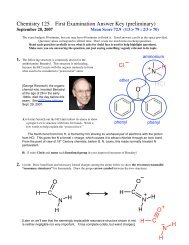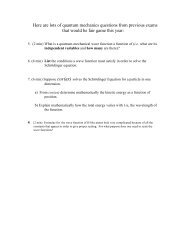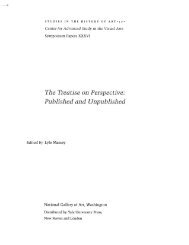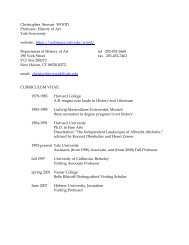Chemistry 125: Instructions for Erwin Meets Goldilocks
Chemistry 125: Instructions for Erwin Meets Goldilocks
Chemistry 125: Instructions for Erwin Meets Goldilocks
Create successful ePaper yourself
Turn your PDF publications into a flip-book with our unique Google optimized e-Paper software.
<strong>Chemistry</strong> <strong>125</strong>: <strong>Instructions</strong> <strong>for</strong> <strong>Erwin</strong> <strong>Meets</strong> <strong>Goldilocks</strong><br />
[Note the 5 problems <strong>for</strong> Monday’s problem set are found at the end of this document. Many of the<br />
details on operating the program relate to an earlier version that would run only on a Mac. The new<br />
JAVA version is much improved and instructions <strong>for</strong> operating it are found by clicking “<strong>Instructions</strong><br />
<strong>for</strong> getting started with Java version <strong>Erwin</strong> <strong>Meets</strong> <strong>Goldilocks</strong>” on the course homepage.]<br />
To become com<strong>for</strong>table with quantum mechanics you must reconstruct an<br />
intuition that was <strong>for</strong>med by activities like throwing balls and stretching springs that<br />
have been your daily activities since early childhood, as well as by Newtonian theory<br />
from previous science courses, such as "kinetic energy = 1/2 mv 2".<br />
Un<strong>for</strong>tunately quantized systems are too small <strong>for</strong> us to experience in any very<br />
direct, physical way, and the arcane nature of differential equations keeps most<br />
people from gaining experience with quantum theory. The first goal <strong>for</strong> <strong>Chemistry</strong><br />
<strong>125</strong> quantum mechanics is to develop a quantum intuition by observing and thinking<br />
about some problems and their solutions (without having to do math explicitly).<br />
Then we'll go on to treat atoms and bonds.<br />
<strong>Erwin</strong> meets <strong>Goldilocks</strong> is a homebuilt tool <strong>for</strong> Chem <strong>125</strong> that allows you to<br />
dabble with the ideas of quantum mechanics without worrying about its mathematical<br />
complexities. It treats a very simple problem (one particle in one dimension) and<br />
draws wave functions that satisfy the Schrödinger equation. Using <strong>Erwin</strong> to see what<br />
happens as you change mass, total energy, and potential energy functions can build a<br />
valuable intuition about many of the most important and surprising phenomena of<br />
quantum mechanics, such as:<br />
Why energies are quantized under some conditions, not under others<br />
Why atoms don't collapse<br />
What makes a bond<br />
Why there is "zero-point energy"<br />
How atoms or electrons can “tunnel”<br />
<strong>Erwin</strong> provides a sort of quantum mechanical laboratory where you can learn by<br />
observing.<br />
The time-independent Schrödinger equation can be rearranged into the following<br />
<strong>for</strong>m, which is a <strong>for</strong>mula <strong>for</strong> the curvature of the wave function Ψ:<br />
d 2Ψ/dx 2 = mass ∗ Ψ ∗ (potential energy - total energy) ∗ (a known positive constant)<br />
For present purposes being given this <strong>for</strong>mula is practically as good as being<br />
given Ψ itself, because as long as you know the amplitude and slope of Ψ at any one
<strong>Erwin</strong> <strong>Meets</strong> <strong>Goldilocks</strong> <strong>Instructions</strong> 9/16/08 Page 2<br />
point, 1 you can start drawing Ψ there and use the curvature given by the equation to<br />
guide your pen along the proper path as potential energy and Ψ change. This is<br />
exactly what the program does. It starts at the left of the screen with small positive<br />
amplitude and zero slope, 2 calculates the curvature, moves to the next point to the<br />
right, calculates the new slope and the new curvature, and so on. As long as the slope<br />
isn’t changing too rapidly, this point-by-point extrapolation will work fine.<br />
Wherever the total energy is greater than the potential energy, the curvature<br />
(positive when Ψ is negative, negative when Ψ is positive) is such as to lead the<br />
function back toward the Ψ = 0 baseline. But in the "classically <strong>for</strong>bidden" regions<br />
(where potential energy is greater than total energy) Ψ can run into trouble, shooting<br />
off to + or - infinity. Only by choosing just the right values of total energy can you<br />
avoid this and have Ψ approach the baseline asymptotically. In bound situations<br />
(where potential energy exceeds total energy in the far regions at both ends), the<br />
energy of systems is quantized in order to give well-behaved, non-infinite wave<br />
functions, which, as far as we can tell from Nature, are the only type that can<br />
represent reality in these situations.<br />
To run the program you must first define the problem by choosing a mass <strong>for</strong><br />
the particle and a <strong>for</strong>m <strong>for</strong> the potential energy as a function of position. To get<br />
started you might choose 1 <strong>for</strong> the mass (the mass of a proton) and specify one of the<br />
potential energies from the following list (depending on the choice there may be<br />
more parameters to specify): 3<br />
Constant (zero) potential energy. This is like a particle in free space.<br />
Decaying Exponential potential energy that starts very high on the left and<br />
falls to become essentially constant at zero on the right. This is like a<br />
particle in free space which can run into a softish wall on the left.<br />
Harmonic Oscillator. This parabolic potential is often used as a crude<br />
approximation of a bond holding the particle (atom) whose mass you have<br />
specified. Such a potential is unrealistic, since the <strong>for</strong>ce pulling the atom<br />
back to the center always keeps increasing, and the bond can never break,<br />
but has been much studied because of mathematical tractability. If you<br />
choose the harmonic oscillator you must specify the strength of the bond<br />
1 The initial amplitude can be set arbitrarily, since multiplying Ψ by a constant makes no difference<br />
in its ability to solve the Schrödinger Equation. In the following applications, it is safe assume<br />
that at the far left of the region of interest the slope is zero, or close enough to zero to make no<br />
difference. Soon you’ll be able to figure out why this is so.<br />
2 The mass can be subsequently altered with the Define Problem / Mass.<br />
3 Initial parameters <strong>for</strong> a given type of potential can be altered with Plot / Edit. The type of<br />
potential may be changed by returning to Define Problem / Potential.
<strong>Erwin</strong> <strong>Meets</strong> <strong>Goldilocks</strong> <strong>Instructions</strong> 9/16/08 Page 3<br />
that holds your particle by typing 1 <strong>for</strong> a single bond, 2 <strong>for</strong> a double, etc.<br />
Fractional values are OK.<br />
Double Minimum is a potential from two intersecting parabolas. This would<br />
represent a particle that is attracted to two other particles, one on the left,<br />
the other on the right by inverse <strong>for</strong>ce laws. Classically it would have to<br />
gather some energy to jump from one well to the other, that is, to move<br />
from being bonded from one neighbor to being bonded to the other. This<br />
potential is ideal <strong>for</strong> studying the phenomenon of tunneling, and the closely<br />
related phenomenon of chemical bonding. Here you are asked to specify<br />
five parameters: the bond strengths on either side of the middle (one bond<br />
could be stronger, but you might begin with them equal), the distance in Å<br />
between the bottoms of the two wells (how far the particle has to move to<br />
change bonds - try someting fairly small at first, perhaps 0.5Å), the<br />
difference in depth of the two wells (you might try 0 kcal/mole at first),<br />
and the amount of "coupling" (this is the amount by which you decide to<br />
lower the energy at the otherwise sharp intersection of the two parabolas, it<br />
makes the potential more realistic by allowing <strong>for</strong>ming the bond to the new<br />
neighbor to help offset the energy requirement of breaking the old one).<br />
Morse is a more realistic bonding potential than the harmonic oscillator,<br />
because it describes a bond that can break. It is characterized by depth, the<br />
energy required to break the bond, and by the curvature at the bottom of the<br />
potential energy well, which is expressed in terms of the equivalent<br />
"harmonic bond strength" (1 <strong>for</strong> single bond, 2 <strong>for</strong> double, etc.). For<br />
plotting purposes you must also specify the distance in Å of the potential<br />
energy minimum from the left edge of the screen. 1<br />
Coulombic (1/distance) potential. This is a sort of one-dimensional H-like<br />
atom (electron in the field of a nucleus). It needs special attention because<br />
as the distance approaches zero, the potential energy falls without limit and<br />
the curvature would become infinite. There are some bugs in this part of the<br />
program, but you should at least see what kind of solutions this potential<br />
has. Remember to choose the small mass of the electron. You are asked to<br />
specify a horizontal plot range (electrons are so light that they can cover<br />
much more territory than nuclei), a maximum calculable binding energy,<br />
i.e. how far below the energy of separated particles you want the graph to<br />
1 For the Morse potential the auto-solve feature of the program may give an erroneous solution that<br />
does not approach the baseline asymptotically. If that happens with the Morse or another<br />
confining potential, increase the horizontal plot range (Dimensions/Distance) until the approach<br />
becomes asymptotic.
<strong>Erwin</strong> <strong>Meets</strong> <strong>Goldilocks</strong> <strong>Instructions</strong> 9/16/08 Page 4<br />
extend (the true potential energy decreases without limit near the nucleus),<br />
and the nuclear charge.<br />
When you have specified the potential, click the Create button to see a plot of<br />
the potential. You may want to rescale the potential energy by changing the upper and<br />
lower limits of the plot (Dimensions / Energy), or you could change the horizontal<br />
range of particle position in Å (Dimensions / Distance). The boundary between gray<br />
and white shows the potential energy (you can change the appearance of the potential<br />
plot with View / Potential Fill Color or Potential Border Color).<br />
You have stated the problem by specifying the mass and the potential, you need<br />
to find the shape of the wave function <strong>for</strong> the particle in this potential. So now click<br />
New Solution to give a colored window to use <strong>for</strong> your guessing game. You are<br />
asked to guess a value <strong>for</strong> the total energy. The computer then superimposes a plot of<br />
Psi with the same horizontal axis as the potential plot. This horizontal axis is the<br />
position of the particle in Å ..<br />
So there are two graphs: One graph is of energy and its vertical axis goes from<br />
zero on the bottom to a value shown at the top left. 1 The energy plot includes both the<br />
potential you have chosen and a horizontal dashed line showing the total energy<br />
you have guessed.<br />
The other graph, superimposed on the energy one, shows the trial wave<br />
function, which the computer draws (according to the total energy you guessed) as a<br />
solid line with Ψ = 0 being a horizontal line across the center of the plot area. Don’t<br />
be confused by the superposition. It is handy because the two plots have the same<br />
horizontal axis (particle position), which makes it easy to see the influence of energy<br />
on the shape of the wave function.<br />
If the wave function doesn't shoot off to + or - infinity anywhere, you've guessed<br />
a proper energy and found a solution (Congratulations! You're either fabulously lucky<br />
or you chose a non-quantized system). If it does shoot off, you need to change your<br />
energy guess in the attempt to keep Ψ finite. You do this by editing the Energy value<br />
colored solution window. Much of your sense of what it means to be quantized will<br />
be developed by the process of guessing again and again, trying to figure out what<br />
will constitute a good guess. (Don't use the Solve option, designed <strong>for</strong> wimps and<br />
people in a hurry who have already mastered the concept, until you've really grasped<br />
this.)<br />
By clicking New Solution you can launch a new guess with a different color<br />
(chosen through Color).<br />
You can spend a lot of time trying to guess an energy that will keep Ψ finite all<br />
the way to the right of the screen. For most quantized problems the program can't<br />
express numbers precisely enough to achieve this goal. It becomes a case of<br />
bracketing a proper energy between one that is too high (and shoots off one way to
<strong>Erwin</strong> <strong>Meets</strong> <strong>Goldilocks</strong> <strong>Instructions</strong> 9/16/08 Page 5<br />
infinity) and one with one fewer nodes that is too low (and shoots off the other way).<br />
This is where <strong>Goldilocks</strong> comes in. Some players get enthralled and continue<br />
guessing to bracket the solution more and more tightly, until they reach the limit of<br />
the computer's precision or their patience.<br />
When you've gotten the idea firmly and are tired of spending so much of your<br />
time guessing, you can use the Solve button in the New Solution window to do the<br />
guessing automatically and find the next-higher-energy (or next-lower-energy)<br />
solution from your current guess. 1<br />
It is possible to save and recall your work under Project.<br />
You can see the plot of probability distribution (Ψ 2 ), by checking the prob box<br />
in the solution window.<br />
As you plot wavefunctions think (in term of the Schrödinger Equation)<br />
about how and why they vary with mass, total energy, potential energy. Think<br />
about where the particle spends its time in states of different energy (Ψ 2 is good<br />
<strong>for</strong> this). Think about the relation of nodes to energy. Think about what is<br />
determining the curvature of Ψ. Think why there can't be a node in a <strong>for</strong>bidden<br />
region at one end of the graph.<br />
If you don't think carefully, your intuition won't develop as rapidly.<br />
GROUP PROBLEMS FOR SEPTEMBER 22<br />
Mostly I'd like you to play around with the program, making discoveries of<br />
your own, so as to build your quantum intuition. You should each learn enough to be<br />
able to answer the following questions. It is unrealistic to think that each of you will<br />
have time to make all of these discoveries <strong>for</strong> yourself and write up answers, so I<br />
suggest that you <strong>for</strong>m groups of up to five students and collaborate (Experience<br />
suggests that 3 in a group gives the best learning. You can turn in one set of answers<br />
on Monday, September 24 <strong>for</strong> the group as a whole. Get together and discuss what<br />
you're finding as you go along, then assign the write-up responsibilities <strong>for</strong> different<br />
problems (or parts of problems) to different individuals. Teach each other what<br />
you've learned. Don't just copy or let your friends learn without explaining to you.<br />
Don't allow yourself to get frustrated. If in working together you don't see the<br />
answer, seek help. It's simplest to work the problems in the order given. Start early.<br />
1 Solve works by guessing and bracketing, just as you do, and it doesn't make Ψ exactly asymptotic<br />
on the right either, it just finds a very good approximation. In fact numerical approximations are<br />
used that mean the wave functions and energies are not precisely accurate anyway. For example,<br />
choosing a high total energy - say 400 kcal/mole - <strong>for</strong> a particle of mass 1 with constant potential<br />
energy should give a cosine wave, but the program plots a wave with increasing amplitude because<br />
of accumulating error. This problem is especially acute when wavelengths are short. If you<br />
want to try moderating this problem you can reduce the step size under Modify Details.
<strong>Erwin</strong> <strong>Meets</strong> <strong>Goldilocks</strong> <strong>Instructions</strong> 9/16/08 Page 6<br />
Troubleshooting: The most common difficulty <strong>for</strong> beginners is when the<br />
program appears to draw no Ψ at all. This results from choosing systems that<br />
involve too large a range in which the potential energy is far above the total<br />
energy, so that the computer isn't precise enough to keep Ψ manageable over<br />
the range of interest. You can narrow the range (or increase the total energy).<br />
You can get a nonsensical Ψ by guessing too high a total energy (or mass),<br />
making the wavelength too small <strong>for</strong> the program's approximations to deal with<br />
properly.<br />
WARNING: The observations and questions in the problem set below make<br />
excellent exam fodder.<br />
1. Use constant potential energy to study how mass and total energy influence Ψ.<br />
Try to discover quantitative relationships. [This relates to using an electron<br />
microscope to "see" objects with high resolution (the electron's mass is 0.00054 of<br />
the proton's; because it's so light try 50 kcal/mole and 10Å plot width <strong>for</strong> a start)].<br />
2. Use the exponential potential energy to see how easy it is to find a satisfactory<br />
Ψ when the system is confined on only one side. In what ways is this Ψ similar to<br />
the Ψ <strong>for</strong> constant potential energy? Explain the behaviour of Ψ in regions of<br />
negative kinetic energy. How can you tell by looking at Ψ what region has potential<br />
energy greater than total energy (and thus negative kinetic energy) and at what point<br />
they are the same (zero kinetic energy)?<br />
3. Use the harmonic oscillator to see how hard it is to find a satisfactory Ψ when<br />
the system is energetically confined (“bounded”) on both sides. Find the lowest<br />
energy Ψ (no nodes) and the next lowest (one node). Then try to predict at what<br />
energies other successive Ψs will be found, and see if you are right. What is the<br />
pattern of allowed energies, and how does it relate to the lowest possible energy?<br />
(This so-called zero-point energy, of the Ψ with zero nodes, is the minimum energy<br />
such a system must have even at absolute zero of temperature.) What happens to the<br />
lowest allowed energy if you double the mass, and how does it change with the<br />
strength of the bond? 1 Where does the particle with the lowest allowed energy spend<br />
most of its time? How about one in the tenth energy level? (Where does a classical<br />
pendulum spend most of its time?)<br />
4. Use the Morse potential to see how a system can be quantized <strong>for</strong> some energies<br />
and not <strong>for</strong> others. How similar is its progression of allowed energies to that of the<br />
harmonic oscillator with the same bond strength?<br />
1 This is the source of proton/deuterium isotope effects.
<strong>Erwin</strong> <strong>Meets</strong> <strong>Goldilocks</strong> <strong>Instructions</strong> 9/16/08 Page 7<br />
5. Use the double minimum potential to see how a particle can "tunnel" through a<br />
region where it has negative kinetic energy. Do this by finding a pair of satisfactory<br />
Ψs with energies that are near, but below, the top of the hill between two equivalent<br />
valleys. The lower one must have an even number of nodes, and the upper one must<br />
have one additional node. The energy difference between these functions, expressed<br />
as a frequency, is how fast the particle would tunnel through the energy barrier<br />
(multiply kcal/mole by 10 13 to get jumps per second).


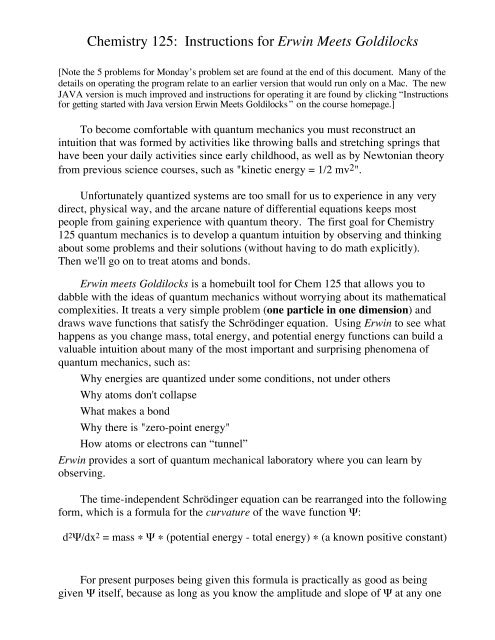
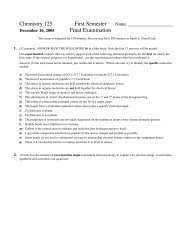
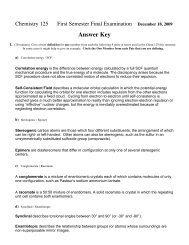
![Review: [untitled] Author(s): Christopher S. Wood ... - Yale University](https://img.yumpu.com/47633680/1/184x260/review-untitled-authors-christopher-s-wood-yale-university.jpg?quality=85)

